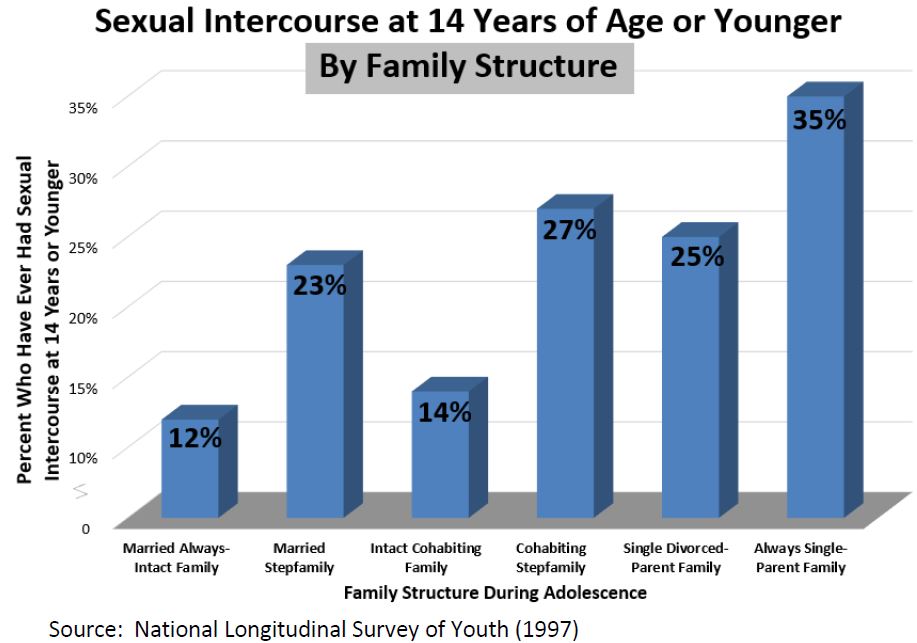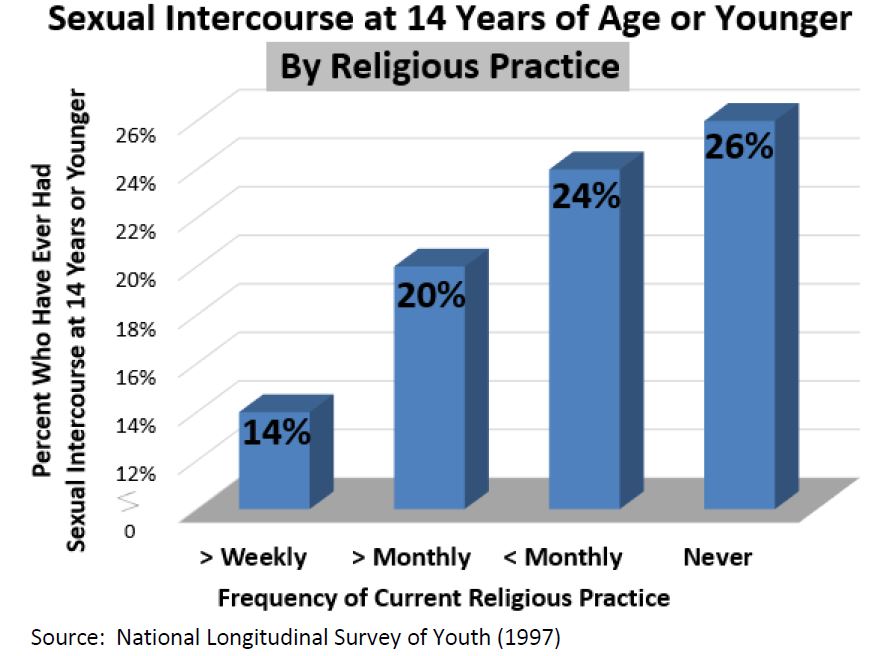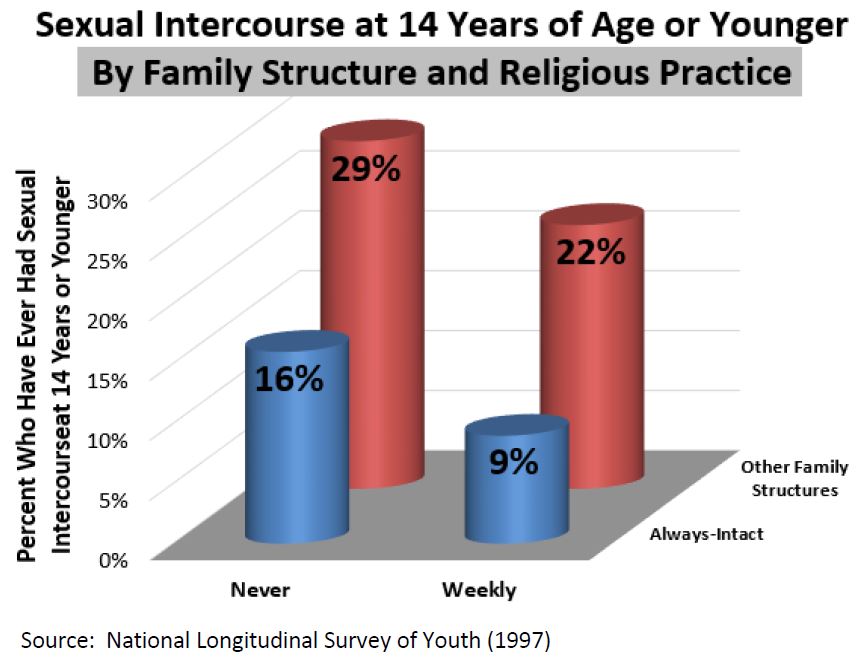Click Here to download “Sexual Intercourse at 14 Years of Age or Younger by Family Structure and Religious Practice”
Sexual Intercourse at 14 Years of Age or Younger by Family Structure and Religious Practice
The 1997 National Longitudinal Survey of Youth showed that, among adolescents 14 and younger, those who grew up in married, intact families and attended weekly religious services at the time of the survey were the least likely to have had sexual intercourse.
[1]
Family Structure: According to the National Longitudinal Survey of Youth, 12 percent of adolescents who grew up in an intact married family ever had sexual intercourse at 14 years of age or younger, followed by children of intact cohabiting families (14 percent), children of married stepfamilies (23 percent), single divorced-parent families (25 percent), cohabiting stepfamilies (27 percent) and always-single parent households (35 percent).
 Religious Practice:
Religious Practice: Only 14 percent of adolescents who attended weekly religious services at the time of the survey had ever had sexual intercourse at 14 years of age or younger, compared to those who attended church one to three times a month (20 percent), less than monthly (24 percent), and those who never attended church (26 percent).
 Family Structure and Religious Practice Combined:
Family Structure and Religious Practice Combined: The National Longitudinal Survey of Youth shows that 9 percent of adolescents who grew up in intact married families and attended church weekly at the time of the survey had ever had sexual intercourse at 14 years of age or younger, followed by those who never attended church but grew up in an always intact married family (16 percent). Twenty-two percent of adolescents from all other family structures who attended church weekly had ever had sexual intercourse at 14 years of age or younger, followed by those who never attended church and grew up in all other family structures (29 percent).
 Related Insights from Other Studies:
Related Insights from Other Studies: Data from the Longitudinal cohort study, Project on Human Development in Chicago Neighborhoods, found that adolescents aged 11 to 16 who were living with their biological parents were less likely to engage in sexual intercourse than were their peers who lived without both biological parents.
[2] Data from a different study confirmed this same trend, that teens that live with both parents are significantly less likely to have ever had intercourse than their peers who do not live with both parents.
[3]
Data from the National Survey of Family Growth also found that young girls who lived with both of their biological parents at age 14 had a lower risk of first sexual intercourse than their peers who did not live with both biological parents at 14.
[4]
One study found that those adolescents who emphasized the importance of religion in their lives were less likely to engage in premarital sexual activity. In this study, young women who attended church once or more per week were less likely to be sexually active than those who attended less often. Thirty-eight percent of young women who attended church once or more per week were sexually active. Of those who attended church less often, 65.4 percent were sexually active.
[5]
[1] These charts draw on data collected by the National Longitudinal Survey of Youth (1997).
[2] Browning, C.R. T. Leventhal and J. Brooks-Gunn, “Neighborhood context and racial differences in early adolescent sexual activity, “
Demography 41
(4) 2004, PP. 697–720.
[3] Collins, R.L., M.N. Elliot, S.H. Berry, D.E. Kanouse, D. Kunkel, S.B. Hunter, “Watching sex on television predicts adolescent initiation of sexual behavior
,” Pediatrics 114
( 3) 2004, pp. 280-289.
[4] Brewster, K. L., E.C. Cooksey, D.K. Guiley, R.R. Rindfuss, “The changing impact of religion on the sexual and contraceptive behavior of adolescent women in the United States,”
Journal of Marriage and Family 60
(2) 1998, pp. 493-504..
[5] Studer, Marlena, Arland Thornton, “Adolescent Religiosity and Contraceptive Usage,”
Journal of Marriage and the Family 49
(1) 1987, pp. 117-128.]]>
 Religious Practice: Only 14 percent of adolescents who attended weekly religious services at the time of the survey had ever had sexual intercourse at 14 years of age or younger, compared to those who attended church one to three times a month (20 percent), less than monthly (24 percent), and those who never attended church (26 percent).
Religious Practice: Only 14 percent of adolescents who attended weekly religious services at the time of the survey had ever had sexual intercourse at 14 years of age or younger, compared to those who attended church one to three times a month (20 percent), less than monthly (24 percent), and those who never attended church (26 percent).
 Family Structure and Religious Practice Combined: The National Longitudinal Survey of Youth shows that 9 percent of adolescents who grew up in intact married families and attended church weekly at the time of the survey had ever had sexual intercourse at 14 years of age or younger, followed by those who never attended church but grew up in an always intact married family (16 percent). Twenty-two percent of adolescents from all other family structures who attended church weekly had ever had sexual intercourse at 14 years of age or younger, followed by those who never attended church and grew up in all other family structures (29 percent).
Family Structure and Religious Practice Combined: The National Longitudinal Survey of Youth shows that 9 percent of adolescents who grew up in intact married families and attended church weekly at the time of the survey had ever had sexual intercourse at 14 years of age or younger, followed by those who never attended church but grew up in an always intact married family (16 percent). Twenty-two percent of adolescents from all other family structures who attended church weekly had ever had sexual intercourse at 14 years of age or younger, followed by those who never attended church and grew up in all other family structures (29 percent).
 Related Insights from Other Studies: Data from the Longitudinal cohort study, Project on Human Development in Chicago Neighborhoods, found that adolescents aged 11 to 16 who were living with their biological parents were less likely to engage in sexual intercourse than were their peers who lived without both biological parents. [2] Data from a different study confirmed this same trend, that teens that live with both parents are significantly less likely to have ever had intercourse than their peers who do not live with both parents.[3]
Data from the National Survey of Family Growth also found that young girls who lived with both of their biological parents at age 14 had a lower risk of first sexual intercourse than their peers who did not live with both biological parents at 14.[4]
One study found that those adolescents who emphasized the importance of religion in their lives were less likely to engage in premarital sexual activity. In this study, young women who attended church once or more per week were less likely to be sexually active than those who attended less often. Thirty-eight percent of young women who attended church once or more per week were sexually active. Of those who attended church less often, 65.4 percent were sexually active.[5]
[1] These charts draw on data collected by the National Longitudinal Survey of Youth (1997).
[2] Browning, C.R. T. Leventhal and J. Brooks-Gunn, “Neighborhood context and racial differences in early adolescent sexual activity, “Demography 41(4) 2004, PP. 697–720.
[3] Collins, R.L., M.N. Elliot, S.H. Berry, D.E. Kanouse, D. Kunkel, S.B. Hunter, “Watching sex on television predicts adolescent initiation of sexual behavior,” Pediatrics 114( 3) 2004, pp. 280-289.
[4] Brewster, K. L., E.C. Cooksey, D.K. Guiley, R.R. Rindfuss, “The changing impact of religion on the sexual and contraceptive behavior of adolescent women in the United States,” Journal of Marriage and Family 60(2) 1998, pp. 493-504..
[5] Studer, Marlena, Arland Thornton, “Adolescent Religiosity and Contraceptive Usage,” Journal of Marriage and the Family 49(1) 1987, pp. 117-128.]]>
Related Insights from Other Studies: Data from the Longitudinal cohort study, Project on Human Development in Chicago Neighborhoods, found that adolescents aged 11 to 16 who were living with their biological parents were less likely to engage in sexual intercourse than were their peers who lived without both biological parents. [2] Data from a different study confirmed this same trend, that teens that live with both parents are significantly less likely to have ever had intercourse than their peers who do not live with both parents.[3]
Data from the National Survey of Family Growth also found that young girls who lived with both of their biological parents at age 14 had a lower risk of first sexual intercourse than their peers who did not live with both biological parents at 14.[4]
One study found that those adolescents who emphasized the importance of religion in their lives were less likely to engage in premarital sexual activity. In this study, young women who attended church once or more per week were less likely to be sexually active than those who attended less often. Thirty-eight percent of young women who attended church once or more per week were sexually active. Of those who attended church less often, 65.4 percent were sexually active.[5]
[1] These charts draw on data collected by the National Longitudinal Survey of Youth (1997).
[2] Browning, C.R. T. Leventhal and J. Brooks-Gunn, “Neighborhood context and racial differences in early adolescent sexual activity, “Demography 41(4) 2004, PP. 697–720.
[3] Collins, R.L., M.N. Elliot, S.H. Berry, D.E. Kanouse, D. Kunkel, S.B. Hunter, “Watching sex on television predicts adolescent initiation of sexual behavior,” Pediatrics 114( 3) 2004, pp. 280-289.
[4] Brewster, K. L., E.C. Cooksey, D.K. Guiley, R.R. Rindfuss, “The changing impact of religion on the sexual and contraceptive behavior of adolescent women in the United States,” Journal of Marriage and Family 60(2) 1998, pp. 493-504..
[5] Studer, Marlena, Arland Thornton, “Adolescent Religiosity and Contraceptive Usage,” Journal of Marriage and the Family 49(1) 1987, pp. 117-128.]]>
